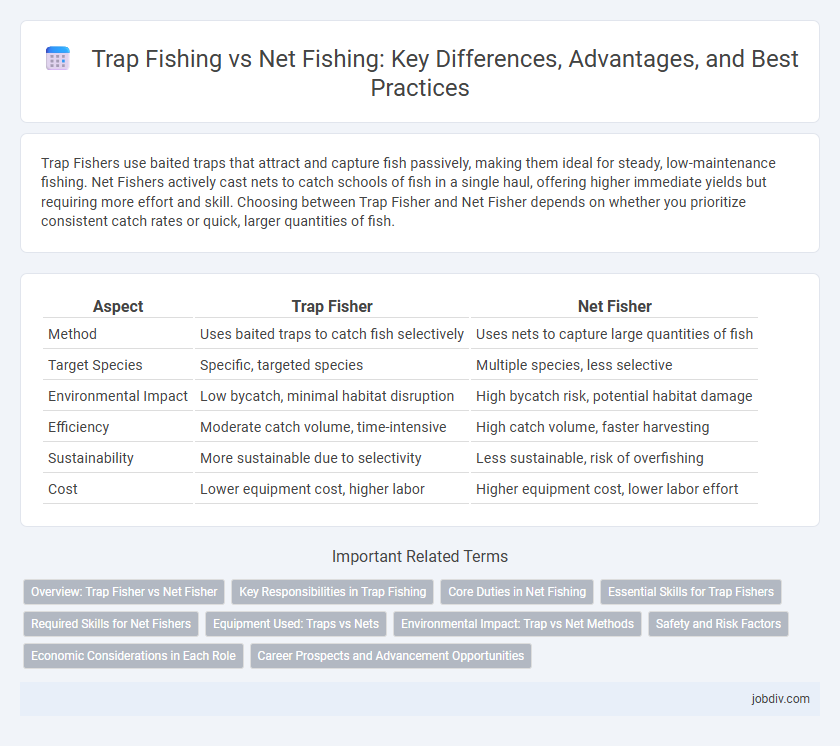Trap Fishers use baited traps that attract and capture fish passively, making them ideal for steady, low-maintenance fishing. Net Fishers actively cast nets to catch schools of fish in a single haul, offering higher immediate yields but requiring more effort and skill. Choosing between Trap Fisher and Net Fisher depends on whether you prioritize consistent catch rates or quick, larger quantities of fish.
Table of Comparison
| Aspect | Trap Fisher | Net Fisher |
|---|---|---|
| Method | Uses baited traps to catch fish selectively | Uses nets to capture large quantities of fish |
| Target Species | Specific, targeted species | Multiple species, less selective |
| Environmental Impact | Low bycatch, minimal habitat disruption | High bycatch risk, potential habitat damage |
| Efficiency | Moderate catch volume, time-intensive | High catch volume, faster harvesting |
| Sustainability | More sustainable due to selectivity | Less sustainable, risk of overfishing |
| Cost | Lower equipment cost, higher labor | Higher equipment cost, lower labor effort |
Overview: Trap Fisher vs Net Fisher
Trap fishers use stationary or baited enclosures to capture aquatic species, targeting specific habitats and minimizing bycatch. Net fishers deploy various net types, such as gillnets or trawls, covering larger water areas and catching multiple species simultaneously, often resulting in higher bycatch rates. Efficiency and environmental impact vary significantly, with trap fishing being more selective and sustainable compared to the broader, often more disruptive net fishing methods.
Key Responsibilities in Trap Fishing
Trap fishers are responsible for setting, monitoring, and retrieving traps to efficiently capture target species such as crabs, lobsters, or fish. Their duties include maintaining trap equipment, ensuring proper baiting techniques, and adhering to regulations regarding trap placement and catch limits. Accurate record-keeping and sustainable practices are essential to minimize ecological impact and maintain healthy fish populations.
Core Duties in Net Fishing
Net fishers primarily focus on deploying, managing, and retrieving fishing nets designed to capture large quantities of fish efficiently. Their core duties include selecting appropriate net types, monitoring catch size and species to comply with regulations, and maintaining net integrity to prevent loss or damage. Precise handling and timely operation are essential to maximize catch yield while minimizing environmental impact.
Essential Skills for Trap Fishers
Trap fishers require precise knowledge of local fish behavior and habitats to strategically place traps for maximum catch efficiency. Mastery in setting and maintaining durable traps that withstand environmental conditions is essential for sustainable fishing. Expertise in selecting appropriate bait and analyzing seasonal patterns directly influences the success rate of capturing target fish species.
Required Skills for Net Fishers
Net fishers require advanced skills in net handling, precise casting techniques, and understanding aquatic movement patterns to maximize catch efficiency. Proficiency in identifying optimal fishing zones based on water currents and fish behavior is essential for successful net fishing. Mastery in quickly setting, retrieving, and maintaining nets ensures minimal fish escape and equipment longevity.
Equipment Used: Traps vs Nets
Trap fishers use specialized baited containers or enclosures designed to lure and capture fish alive, ensuring minimal habitat disruption and selective harvesting. Net fishers deploy various types of nets, such as gillnets, seine nets, or trawls, capable of capturing large quantities of fish simultaneously but often result in higher bycatch and environmental impact. The equipment choice profoundly influences fishing efficiency, target species, and ecological sustainability within fisheries management.
Environmental Impact: Trap vs Net Methods
Trap fishing minimizes bycatch and habitat destruction by selectively capturing target species, preserving marine biodiversity and seabed integrity. In contrast, net fishing often results in higher bycatch rates, including endangered species, and can cause significant damage to underwater ecosystems due to dragging nets. Sustainable fishing practices favor trap methods to reduce ecological footprint and maintain healthy fish populations.
Safety and Risk Factors
Trap fishers experience lower injury rates due to the stationary nature of traps, reducing exposure to harsh weather and physical strain. Net fishers face higher risks from entanglement, capsizing, and harsh ocean conditions, increasing the likelihood of accidents and emergency situations. Proper training and safety equipment are critical for both methods to mitigate operational hazards effectively.
Economic Considerations in Each Role
Trap fishers invest in durable gear with lower maintenance costs, enabling steady income through selective catch methods that minimize bycatch and preserve fish stocks. Net fishers face higher operational expenses due to frequent repairs and fuel consumption, but benefit from larger haul volumes, potentially increasing short-term revenues despite greater environmental impact. Economic sustainability varies as trap fishing supports long-term resource management, while net fishing offers rapid returns with fluctuating resource availability.
Career Prospects and Advancement Opportunities
Trap fishers often benefit from specialized skills in setting and monitoring traps, offering steady roles in local fisheries with moderate advancement into supervisory or aquaculture management positions. Net fishers possess versatile expertise in various netting techniques, enabling broader career options including deep-sea commercial fishing and roles in fish processing or equipment maintenance. Net fishing generally provides wider career prospects due to its scalability and integration in larger fishing operations compared to the more localized focus of trap fishing.
Trap Fisher vs Net Fisher Infographic

 jobdiv.com
jobdiv.com